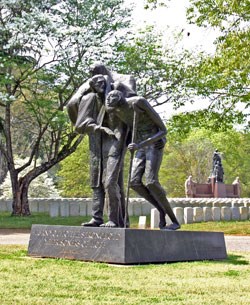
NPS/Andersonville National Cemetery Sixty years after the Minnesota monument was erected in 1916, the last state monument to be placed in the park was dedicated. Governor Jimmy Carter, who had worked toward's Andersonville's inclusion in the National Park System, encouraged the State of Georgia to place a monument at the park. Dedicated on Memorial Day 1976, the Georgia Monument serves as a memorial to all American prisoners of war. In his own words, sculptor William Thompson described his imagery and intent in designing the Georgia Monument:
In creating a sculpture for Andersonville National Historic Site, it was my intention to design a monument which is sculpturally strong and humanly moving. This sculpture is dedicated to all American prisoners involved in all American wars over our country's birth up to the present. The sculpture is designed to have a universal quality, and no reference to any particular uniform or specific details have been made. The accent has been placed on the inner struggle and strength of the prisoners. The statue is intended to speak directly to the viewer in its formal sculpture statement, and about the strength of brotherhood and man's dependence upon God, in its symbolism. The placement of the figures marching in a broken line is to call to mind the formations that all prison camps require. The placement of the prisoners on the incline plane of the granite base emphasizes the fact that it is an uphill struggle just to survive under prison camp conditions. These men have exhausted their human resources and now look beyond one another to God for strength. (Note description on the base.) The two figures in front are united by the overlapping of their arms, which accent the supportive nature of the group. The support of a fellow prisoner often made the difference between life and death, and the sculpture composition and gesture of the monument is to bring this fact into dramatic focus. Men are often captured as a result of their battle wounds, and others develop maladies and injuries during their imprisonment, therefore, I decided to depict my prisoners with wounds. The sculpture is open to interpretation - however, my thoughts in the creation of this work is as follows: The crippled figure (figure with crutch) is suffering humanity, beaten and near desperation. The central figure is the Christ figure, accepting man's burdens and sufferings and supporting him at the same time. The back figure can be seen in several ways. He may be blind and led by the central figure or may be a malaria victim; he may be near death, or an angel of death; but in all cases he is detached from the first two, yet still is part of the group. Sculpture, like music, can have two parts: the lyrics, or story-telling portion, and the music, which is the language of sound speaking directly to the ear in rhythms, tones and melodies. In sculpture, the previous description of the meaning of the symbolism could be likened to the lyrics in a musical score and brief description of that form that I am about to give, to the language of sound; but instead of sound it is the language of vision and volume. The composition is based on variations of cones and triangles; the figures are modified, inverted triangles and the open spaces between the figures are variations on a triangle. The broken arm, the arm holding the crutch, and the group itself are all triangular and are orchestrated so that these triangles create movements and crescendos. To me, art is a matter of spirit, and it is to the spirit of these men and the spirit of the country from which they came that we honor with this sculpture. |
Last updated: October 31, 2018
